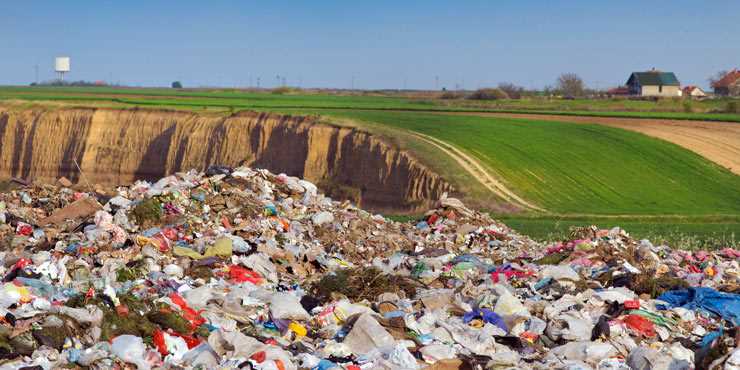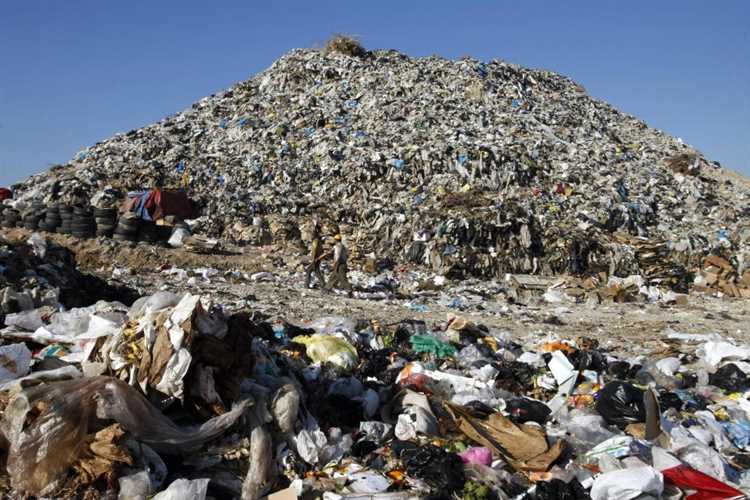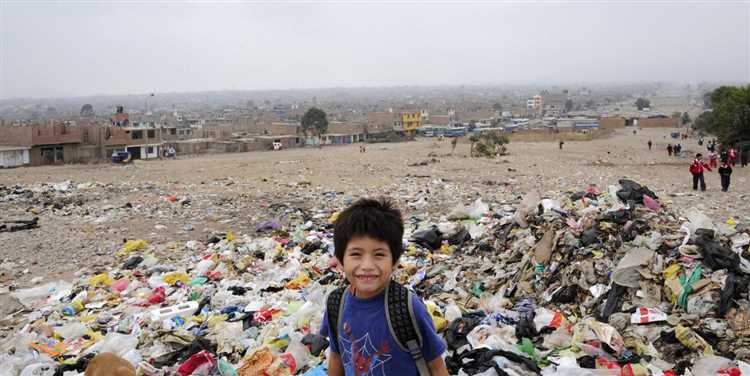
When it comes to waste management, the United States faces numerous challenges. With a population of over 300 million people, the country generates an enormous amount of waste on a daily basis. From household trash to industrial waste, the issue of where to dispose of all this garbage is a pressing concern.
One of the most common methods of waste disposal in America is landfilling. Landfills are specially designated areas where waste is buried underground. However, landfills are not without their problems. They take up valuable land space and can contaminate the surrounding soil and water sources. In addition, the decomposition of waste in landfills produces methane gas, a potent greenhouse gas that contributes to climate change.
Another method of waste disposal in the US is incineration. Waste incineration involves burning solid waste at high temperatures to reduce its volume and generate energy. While this method is effective at reducing the amount of waste that ends up in landfills, it also has its drawbacks. Incineration releases harmful pollutants into the air, such as dioxins and ash, which can have negative effects on human health and the environment.
As the US continues to grapple with the issue of waste disposal, there is an increasing emphasis on recycling and waste reduction. Recycling involves the process of collecting, sorting, and processing materials that would otherwise be thrown away, and turning them into new products. This not only reduces the amount of waste that goes to landfills or incinerators, but also conserves natural resources and reduces energy consumption.
Ultimately, finding sustainable solutions for waste management is crucial for the well-being of both the environment and future generations. As Americans become more conscious of their waste production and its impact, it is important to continue exploring innovative methods of waste disposal and encouraging individuals to reduce, reuse, and recycle.
- The Problem of Waste Disposal in America
- Landfills: America’s Primary Waste Disposal Solution
- The Importance of Landfills
- Regulation and Management
- Sustainable Waste Management
- Recycling: A Sustainable Alternative to Landfills
- Environmental Benefits of Recycling
- Economic Benefits of Recycling
- Incineration: Burning Waste for Energy
- The Incineration Process
- Benefits of Incineration
- Hazardous Waste: The Environmental Impact and Proper Disposal
- Environmental Impact
- Proper Disposal
- E-Waste: The Growing Concern of Electronic Waste Disposal
- The Environmental Impact
- The Global Dimensions
- Q&A
- What are some of the main types of waste generated in the United States?
- How does the United States dispose of its waste?
- Are there any environmental concerns associated with waste disposal in the United States?
- What are some alternatives to traditional waste disposal methods?
- How can individuals help reduce waste in the United States?
- What is the article about?
The Problem of Waste Disposal in America
America is facing a major challenge when it comes to waste disposal. The country generates a large amount of waste every day, and finding sustainable and efficient ways to handle this waste has become a pressing issue.
One of the main problems with waste disposal in America is the reliance on landfills. Landfills are sites where waste is buried, but they can have negative impacts on the environment and public health. Landfills produce harmful greenhouse gases, such as methane, which contribute to climate change. Additionally, they pose a risk of contaminating soil and water sources if not properly managed.
Another issue is the improper disposal of hazardous waste. Many Americans are not aware of how to dispose of hazardous materials correctly, which can lead to pollution and health risks. Hazardous waste includes items like batteries, paint, and cleaning products, which can release toxic substances if not handled properly.
Recycling is often touted as a solution to waste disposal problems, but America has a long way to go in improving its recycling rates. Many recyclable items end up in landfills because of inadequate recycling infrastructure and lack of awareness.
To address these issues, it is crucial for America to invest in more sustainable waste disposal methods, such as waste-to-energy facilities and recycling centers. These facilities can help reduce the amount of waste going to landfills and harness energy from waste materials. Furthermore, education and awareness campaigns are needed to educate the public about proper waste disposal, including the importance of recycling and the correct handling of hazardous materials.
The problem of waste disposal in America requires concerted efforts from individuals, businesses, and the government to find sustainable solutions. By reducing waste generation, improving recycling rates, and embracing more sustainable waste management practices, America can mitigate the environmental and health impacts of improper waste disposal and move towards a cleaner and greener future.
Landfills: America’s Primary Waste Disposal Solution
Landfills play a critical role in the waste management system of the United States. As the primary waste disposal solution, they provide a place for the safe and regulated disposal of various waste materials.
The Importance of Landfills
Landfills are crucial for several reasons. Firstly, they allow for the organized and efficient disposal of waste generated by households, businesses, and industries. This ensures that waste is not scattered across the environment, preventing contamination and potential hazards.
Secondly, landfills provide a means for the storage and containment of non-biodegradable materials such as plastics, glass, and metals. These materials take a long time to decompose and would otherwise pose a significant threat to the environment if not properly managed.
Additionally, landfills contribute to the reduction of greenhouse gas emissions. Methane, a potent greenhouse gas emitted during the decomposition of organic waste, can be captured and used as a source of renewable energy. Many landfills have implemented systems to collect and utilize methane gas, ultimately benefiting the environment.
Regulation and Management
The operation of landfills in the United States is strictly regulated to ensure environmental protection and public safety. Federal and state agencies have established guidelines and standards that must be followed by landfill operators.
These regulations include requirements for site selection, design, construction, and maintenance. They also outline protocols for monitoring and testing to prevent groundwater contamination and air pollution. Landfill operators are also responsible for post-closure management, which includes long-term monitoring and maintenance to ensure the site remains safe and environmentally sound.
Sustainable Waste Management
While landfills are an essential part of waste management, it is important to promote sustainable practices to minimize the amount of waste being sent to landfills. Recycling, composting, and waste reduction initiatives can help divert materials from landfills and minimize the environmental impact of waste disposal.
- Recycling: Encouraging the recycling of materials such as paper, plastic, and metal can significantly reduce the volume of waste sent to landfills.
- Composting: Organic waste, such as food scraps and yard trimmings, can be composted and used as nutrient-rich soil amendments instead of being disposed of in landfills.
- Waste Reduction: Implementing measures to reduce waste generation through education, product design, and packaging strategies can help limit the amount of waste produced in the first place.
By embracing sustainable waste management practices, the reliance on landfills can be reduced, and the overall environmental impact of waste disposal can be minimized.
Recycling: A Sustainable Alternative to Landfills
Landfills have long been the traditional method for disposing of waste in America, but as the population grows and waste accumulates, this method is becoming increasingly unsustainable. Recycling is a viable solution that not only reduces the amount of waste sent to landfills but also helps to conserve resources and protect the environment.
Environmental Benefits of Recycling
One of the primary benefits of recycling is its positive impact on the environment. By recycling materials such as paper, plastic, glass, and metal, we can reduce the need for extracting and processing raw materials. This, in turn, conserves energy and reduces greenhouse gas emissions. Moreover, recycling helps to prevent pollutants from leaching into soil and water, preventing environmental damage.
Economic Benefits of Recycling
Aside from its environmental benefits, recycling also offers economic advantages. Recycling industries create jobs and contribute to the economy by processing and manufacturing recycled materials. Additionally, by reducing the waste that goes to landfills, recycling helps to reduce disposal costs for municipalities and taxpayers.
| Recycling | Landfills |
|---|---|
| Conserves resources | Depletes resources |
| Reduces energy consumption | Requires energy for operation |
| Helps prevent pollution | Potential for pollution |
| Creates jobs | No job creation |
It’s important for individuals and communities to actively participate in recycling efforts. This can be done by separating recyclable materials from regular waste, using recycling bins, and supporting local recycling programs. Together, we can make a positive impact on the environment and work towards a sustainable future.
Incineration: Burning Waste for Energy
Incineration, also known as waste-to-energy, is a method of waste disposal that involves the combustion of waste materials. This process is becoming increasingly popular due to its ability to generate energy in the form of electricity and heat.
The Incineration Process
During incineration, waste materials are burned at high temperatures in specially designed facilities called waste incinerators. The heat generated from the combustion process is used to produce steam, which can then be used to drive turbines and generate electricity. The remaining ash from the combustion process is typically treated and disposed of in a controlled manner.
Incineration plants are designed with advanced pollution control technologies to minimize the release of harmful emissions into the atmosphere. These technologies include scrubbers, filters, and electrostatic precipitators, which capture pollutants such as particulate matter, heavy metals, and acidic gases.
Benefits of Incineration

Incineration offers several benefits as a waste management method. Firstly, it reduces the volume of waste that ends up in landfills, helping to conserve limited landfill space. Secondly, it reduces the emission of greenhouse gases compared to landfilling, as the combustion process releases carbon dioxide instead of methane, which is a more potent greenhouse gas. Finally, incineration produces energy, which can be used to offset the use of fossil fuels and reduce dependence on non-renewable resources.
However, incineration also has its drawbacks. The process generates air pollutants, including dioxins, furans, and heavy metals, which can have detrimental effects on human health and the environment if not properly controlled. Additionally, the cost of building and operating incineration plants can be substantial.
Conclusion
Incineration, or waste-to-energy, is an effective method of waste disposal that generates energy while reducing the volume of waste going to landfills. However, careful attention must be given to the proper management of emissions and the implementation of pollution control technologies. The potential benefits of incineration must be balanced with its potential drawbacks to ensure a sustainable waste management solution.
Reference:
“Waste Incineration.” United Nations Environment Programme, 2018, www.unenvironment.org/explore-topics/waste/what-we-do/branch/chemicals-and-waste-management-programme/waste-incineration
Hazardous Waste: The Environmental Impact and Proper Disposal

Hazardous waste refers to any material that poses a substantial threat to the environment and human health. This includes toxic chemicals, heavy metals, radioactive materials, and infectious substances. Improper disposal of hazardous waste can have severe consequences, including contamination of soil, water, and air, as well as long-term health risks for both wildlife and humans.
Environmental Impact
The environmental impact of hazardous waste can be devastating. When hazardous waste is not disposed of properly, it can seep into soil and contaminate groundwater, making it unfit for consumption. This contamination can spread to nearby bodies of water and affect aquatic ecosystems, leading to the death of fish and other wildlife. Additionally, airborne pollutants can be released into the atmosphere, contributing to air pollution and climate change.
Hazardous waste also has long-term effects on the environment. For example, certain chemicals can persist in the environment for years and accumulate in the tissues of animals, causing reproductive and developmental issues. The impact of hazardous waste can extend beyond the immediate area of disposal, affecting ecosystems and communities far beyond the original location.
Proper Disposal
Proper disposal of hazardous waste is essential to prevent its harmful effects. Governments and regulatory agencies have established strict guidelines for the handling and disposal of hazardous materials. Some common methods of disposal include recycling, incineration, and secure landfills.
Recycling hazardous waste involves extracting valuable materials or converting them into less harmful substances. This reduces the amount of waste that needs to be disposed of and conserves resources. Incineration is another method where hazardous waste is burned at high temperatures, reducing its volume and converting it into less harmful byproducts. Secure landfills are designed to safely contain hazardous waste, preventing its release into the environment.
| Advantages of Proper Disposal | Disadvantages of Improper Disposal |
|---|---|
|
|
It is crucial for individuals, businesses, and industries to adhere to proper hazardous waste disposal practices. By doing so, we can minimize the environmental impact, protect ecosystems, and ensure a safer future for generations to come.
E-Waste: The Growing Concern of Electronic Waste Disposal
The rapid advancement of technology has led to a surge in electronic consumption, resulting in an alarming increase in electronic waste, also known as e-waste. As electronic devices become obsolete at a staggering pace, the proper disposal of these items has become a pressing issue.
The Environmental Impact
Electronics contain toxic materials such as lead, mercury, cadmium, and brominated flame retardants, which can have detrimental effects on both human health and the environment. When improperly disposed of, these hazardous substances can leach into the soil and water, contaminating ecosystems and posing a significant threat to wildlife and nearby communities.
Furthermore, the extraction of precious metals and rare earth elements used in electronic devices contributes to deforestation, habitat destruction, and increased carbon emissions.
The Global Dimensions
E-waste is a global issue that crosses national boundaries. Developed countries, including the United States, often export their e-waste to developing nations. These countries, lacking adequate infrastructure and regulations for proper disposal, often face significant environmental and health risks as a result. The improper handling and dismantling of e-waste in these regions release harmful chemicals into the air and water, impacting both local communities and the global environment.
Moreover, e-waste often ends up in informal recycling operations, where workers are exposed to hazardous conditions without proper protective gear. This not only jeopardizes their health but can also lead to exploitative practices and low wages.
- According to the United Nations, around 50 million metric tons of e-waste is generated globally every year.
- Only a small percentage of e-waste is properly recycled, with the majority being discarded in landfills or incinerated.
- Efforts to address e-waste include legislation and policies that promote responsible disposal, extended producer responsibility, and the development of recycling infrastructure.
In conclusion, e-waste is a growing concern that demands immediate attention. It is crucial for individuals, governments, and industries to prioritize proper disposal and recycling of electronic devices to mitigate the environmental and health risks associated with e-waste. Only through collective action can we achieve a more sustainable approach to electronic waste management.
Q&A
What are some of the main types of waste generated in the United States?
Some of the main types of waste generated in the United States include municipal solid waste, hazardous waste, and industrial waste.
How does the United States dispose of its waste?
The United States disposes of its waste through various methods such as landfilling, recycling, and waste-to-energy incineration. Landfilling is the most common method, with approximately 54% of waste being disposed in landfills.
Are there any environmental concerns associated with waste disposal in the United States?
Yes, there are several environmental concerns associated with waste disposal in the United States. These include the potential for groundwater contamination from landfills, air pollution from waste incineration, and the depletion of natural resources through excessive waste generation.
What are some alternatives to traditional waste disposal methods?
Some alternatives to traditional waste disposal methods include composting organic waste, implementing waste reduction and recycling programs, and exploring new technologies for waste treatment, such as anaerobic digestion and plasma gasification.
How can individuals help reduce waste in the United States?
Individuals can help reduce waste in the United States by practicing the three R’s: reduce, reuse, and recycle. This can be done by minimizing the consumption of single-use items, repurposing or donating items instead of throwing them away, and properly sorting and recycling waste materials.
What is the article about?
The article is about the problem of waste disposal in the United States.